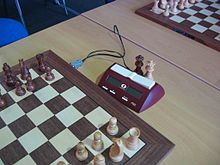Promotion (chess)
Promotion is a chess term describing the transformation of a pawn that reaches the eighth rank into the player's choice of a queen, knight, bishop, or rook of the same color. Promotions to king are also possible in some chess variants, such as suicide chess. In some fairy chess variants, promotions to pieces of the opposite color are also possible.

Promotion to a queen is often referred to as queening. Since the queen is the most powerful piece, the vast majority of promotions in practical play are to a queen. A promotion to a piece other than the queen is called underpromotion, and occurs more often in chess problems than in practical play. A promotion to knight is occasionally useful, particularly if it occurs with check. A promotion to a rook is, on rare occasions, necessary in order to avoid stalemate. Promotion to a bishop almost never occurs in practical play (about one game in 33,000). (See here for examples of underpromotions to rook and bishop made in order to avoid stalemate.)
In the 2006 ChessBase database of 3,200,000 games (largely grandmaster- and master-level), about 1.5 percent of the games contain a promotion. In these games (counting games in which multiple promotions by the same player to the same piece occur only once), the fraction of times each piece was promoted to is approximately:
- queen - 96.9%
- knight - 1.8%
- rook - 1.1%
- bishop - 0.2%
The promotion is not limited to pieces that have been captured. Some finer chess sets (see Chess piece) come with an extra queen of each color to use for promoted pawns. If no queen is available, an upside-down rook is often used to designate a queen.
Strategy
The ability to promote is often the critical factor in endgames and thus is an important consideration in opening and middlegame strategy. Almost all promotions occur in the endgame, but promotion in the middlegame does happen.
Promotion occasionally occurs even in the opening, often after one side makes a blunder, as in the Lasker trap, which features an underpromotion to a knight on move seven. Schlechter-Perlis, 1911 could have featured a promotion to queen on move 11: 1.d4 d5 2.c4 c6 3.Nf3 Nf6 4.e3 Bf5 5.Qb3 Qb6 6.cxd5 Qxb3 7.axb3 Bxb1? 8.dxc6! Be4?? (Perlis avoided the trap with 8...Nc6!, losing more slowly) 9.Rxa7! Rxa7 10.c7 threatening both 11.cxb8(Q) and 11.c8(Q). The British grandmaster Joe Gallagher pulled off a similar idea a half-move earlier in Terentiev-Gallagher, Liechtenstein Open 1990: 1.d4 Nf6 2.Bg5 Ne4 3.Bf4 c5 4.c3 Qb6 5.Qb3 cxd4 6.Qxb6 axb6 7.Bxb8? dxc3 8.Be5?? Rxa2! and now White could have resigned, since if 9.Rxa2, c2 promotes. Another example occurs after 1.e4 c6 2.d4 d5 3.Nc3 dex4 4.Nxe4 Nf6 5.Ng3 h5 6.Bg5? h4 7.Bxf6?? hxg3 8.Be5 Rxh2! 9.Rxh2 Qa5+! 10.c3 Qxe5+! 11.dxe5 gxh2, with the dual threat of 12...hxg1(Q) and 12...h1(Q).
| a | b | c | d | e | f | g | h | ||
| 8 |  | 8 | |||||||
| 7 | 7 | ||||||||
| 6 | 6 | ||||||||
| 5 | 5 | ||||||||
| 4 | 4 | ||||||||
| 3 | 3 | ||||||||
| 2 | 2 | ||||||||
| 1 | 1 | ||||||||
| a | b | c | d | e | f | g | h | ||
There are also a few opening lines where each side gets a "desperado pawn" that goes on a capturing spree, resulting in each side queening a pawn in the opening. An example is seen in the position at left, where play continued 10...bxc3 11.exf6 cxb2 12.fxg7 bxa1(Q) 13.gxh8(Q).
Both players promoted by White's seventh move in Casper-Heckert: 1.e4 Nf6 2.Nc3 d5 3.e5 d4 4.exf6 dxc3 5.d4 cxb2 6.fxg7 bxa1(Q) 7.gxh8(Q).[1]
See also
- King and pawn versus king endgame promoting the pawn in a king and pawn versus king ending, if possible.
- Rook and pawn versus rook endgame promoting the pawn in a rook and pawn versus rook ending, if possible.
- Opposite colored bishops endgame
- Allumwandlung
- Babson task
- Saavedra position
References
- Golombek, Harry (1977), Golombek's Encyclopedia of Chess, Crown Publishing, ISBN 0-517-53146-1
- Hooper, David; Whyld, Kenneth (1992), The Oxford Companion to Chess (second ed.), Oxford University Press, ISBN 0-19-866164-9
